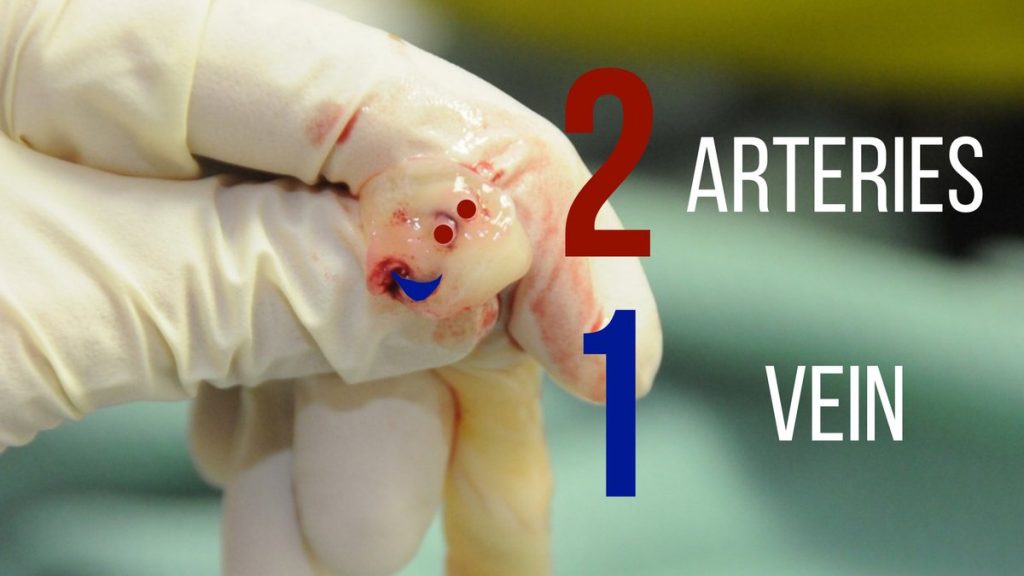Case
You find yourself leading a code pink in L&D, with no pediatricians to be found. You have already moved efficiently through the neonatal resuscitation algorithm, but despite clearing the airway, bagging, and chest compressions, the baby is still flat with a HR of 50. It is time for medications, but your experienced neonatal nurses have not been able to get a line. They look at you expectantly: “umbilical line, doc?”…
Equipment
Ideally, you will have a pre-made umbilical line kit. At minimum, you will require:
- Sterile gloves (plus full sterile gown and drapes if less urgent)
- Chlorhexidine
- Forceps
- Scalpel
- An umbilical line (5 french is standard, 3.5 french in a very premature baby)
- A size 5 feeding tube can be used as a substitute
- Umbilical tape (or a suture for a purse string suture)
- NS flush
My approach to umbilical vein catheterization
Clean the cord and abdomen with chlorhexidine.
Prepare your umbilical line by flushing it with normal saline, and apply a 3 way stopcock (to prevent air embolization).
Tie umbilical tape loosely around the base of the umbilicus. (An alternative to this step would be to place a purse string suture around the base of the cord.)
Holding the cord clamp, use a scalpel to cut perpendicularly through the umbilicus directly below the clamp or about 2cm from the abdominal wall.
Gently grasp the edge of the cord with the forceps.
Identify the larger, single, thin walled umbilical vein (as opposed to the smaller, double, thick walled umbilical arteries).

Gently remove any visible clots at the meatus of the vein.
Gently advance the catheter into the vein. In an emergency setting, only advance to the minimum depth required to get free flowing blood, or approximately 3-5cm.
Aspirate blood, then flush the line.
Tighten the umbilical tape to temporarily secure the line.
Appropriately receive high fives (but don’t forget to continue with the resuscitation).
Notes
The umbilical vein can be accessed up to about 2 weeks of life
Other FOAMed Resources
The normal neonate – navel gazing on Don’t Forget the Bubbles
http://www.uichildrens.org/insertion-of-umbilical-vessel-catheters/
http://www.health.vic.gov.au/neonatalhandbook/procedures/umbilical-vein-catheterisation.htm
References
NEJM video series
http://www.nejm.org/doi/full/10.1056/NEJMvcm0800666
Leacock BW et al. Chapter 32. Neonatal and Pediatric Intraosseous and Central Venous Access. In: Tintinalli JE et al eds. Tintinalli’s Emergency Medicine: A Comprehensive Study Guide, 7e. New York: McGraw-Hill; 2011. http://accessmedicine.mhmedical.com/content.aspx?bookid=348&Sectionid=40381494
Reichman EF et al. Chapter 56. Umbilical Vein Catheterization. In: Reichman EF (ed). Emergency Medicine Procedures, 2e. Toronto: McGraw-Hill; 2013.
Santillanes G and Claudius I. Chapter 19. Pediatric vascular access and blood sampling techniques. In: Roberts JR et al (ed). Roberts and Hedges Clinical Procedures in Emergency Medicine, 6e. Philadelphia: Elsevier; 2014.
Morgenstern, J. Procedure: Umbilical Vein Catheterization, First10EM, March 19, 2015. Available at:
https://doi.org/10.51684/FIRS.140







One thought on “Procedure: Umbilical Vein Catheterization”